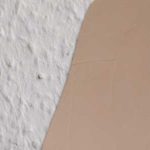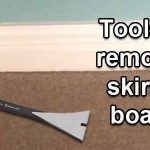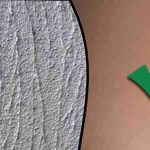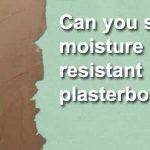If you are re-skimming walls in a property, you generally have 3 choices for application of the plaster.
- You can just over skim the existing surface
- Strip the walls back and then prep them for skimming
- Overboard and skim the plasterboard.
Of these three, re-skimming straight onto the existing surface can often seem like the simplest option. However, not all surfaces are suitable for over skimming.
In most cases, a surface that is covered in wallpaper is not ideal for skimming. But what about textured wallpapers? For example, can you skim over anaglypta wallpaper?
Skimming directly over any type of wallpaper is not recommended, and anaglypta is no different. Your skim coat will only be as good as the paper underneath it. If the paper comes away from the wall, then your plaster will be coming with it.
Also, anaglypta wallpaper is often painted, and this adds further problems for skimming. Something like an emulsion, is another point of possible failure and if it flakes away from the paper, your will again be losing plaster with it.

In theory you could skim over anaglypta with the right prep. However, you are greatly increasing your chance of the surface failing. Therefore, this is definitely not best practice. Really you should strip the paper and then prep the solid sub surface for skimming. Usually this is not a huge job, and this small amount of extra effort will guarantee a far better finish.
What is anaglypta wallpaper?
Anaglypta wallpaper was first created in the late 1800’s in the UK and it is still quite common in modern properties today. The paper is embossed and comes in a wide variety of patterns and designs.
These days, it is slightly less popular, and many people do prefer a smooth skimmed finish on walls. Although, there are situations where this type of textured paper can be preferred.
Textured paper can be used to give a stylish and unique finish when painted, it comes in a variety of styles, including:
- Floral patterns
- Art Deco
- Classic Victorian
- And unique modern designs
With a little creativity and some interior design skills, it is very possible to create a unique and interesting feature using anaglypta wallpaper.
It is also very effective at covering uneven walls. Due to the textured design, it is fantastic at hiding irregularities, which makes it a popular alternative to skimming a wall.
When a surface is uneven, painting will usually make irregularities far more visible. If the wall is skimmed, this will smooth out the wall, giving a high-quality flat finish. However, skimming a wall is a skilled job, and people may opt for the simpler option of hanging anaglypta wallpaper.
How to remove anaglypta wallpaper
Just like other types of wallpaper anaglypta is pretty straight forward to remove. You will just need a scraper and either a steamer, or some warm water in a bucket (you can add a drop of washing up liquid to help).
If the paper is quite stubborn, you can score the surface first and allow the steam or water to soak in. This will make it far easier to remove.
Overall, the process is pretty simple, it’s just a little boring. This is the main reason people may want to cut corners and just skim straight over the anaglypta paper. However, for the small amount of extra effort, you will achieve a far superior finish. You just need to roll your sleeves up and get scraping.
How to prep walls after the paper is removed
Once all of your anaglypta paper has been removed, and the wall has dried out, you will need to prep the wall before it can be reskimmed. The goal is to create the best possible surface for your plaster to adhere too.
The first thing you will need to do is completely remove any small remaining bits of paper. You can do this easily, by using a scraper. Simply run the scraper all over and try to remove and peel away remaining pieces. You can also run a piece of sandpaper over the surface and follow this with some sugar soap wipes to remove any unwanted dirt or grime. This will give your plaster a nice clean surface to stick too.
Once the wall is smooth and free from any dirt and materials, you need to check the quality of the surface you are skimming. Any lose plaster will need removing and any holes or major imperfections will need filling.
For larger holes that go right back to brickwork, you can use a backing plaster such as bonding, and for smaller holes and cracks, a standard filler will be fine.
Once the surface is solid and completely clean, you can prime it with a water PVA mix, or a bonding product such as blue grit. This will reduce suction and provide a better surface for your plaster to key too.
Conclusion
If you are considering skimming over anaglypta wallpaper, then we would advise against it. It is not advised to plaster over any type of wallpaper. The plaster contains a lot of water when it is originally applied. This water will soak into the paper and wallpaper paste and may cause it to lose its grip on the sub surface.
The weight of the plaster will also help to pull the damp paper away from the wall. Due to this, skimming plaster over any type of wallpaper has a high risk of failing at a later date.
Unfortunately, this means you will need to roll your sleeves up and get scraping. It is extra effort, but it will avoid future problems, meaning you only need to do the job once.




